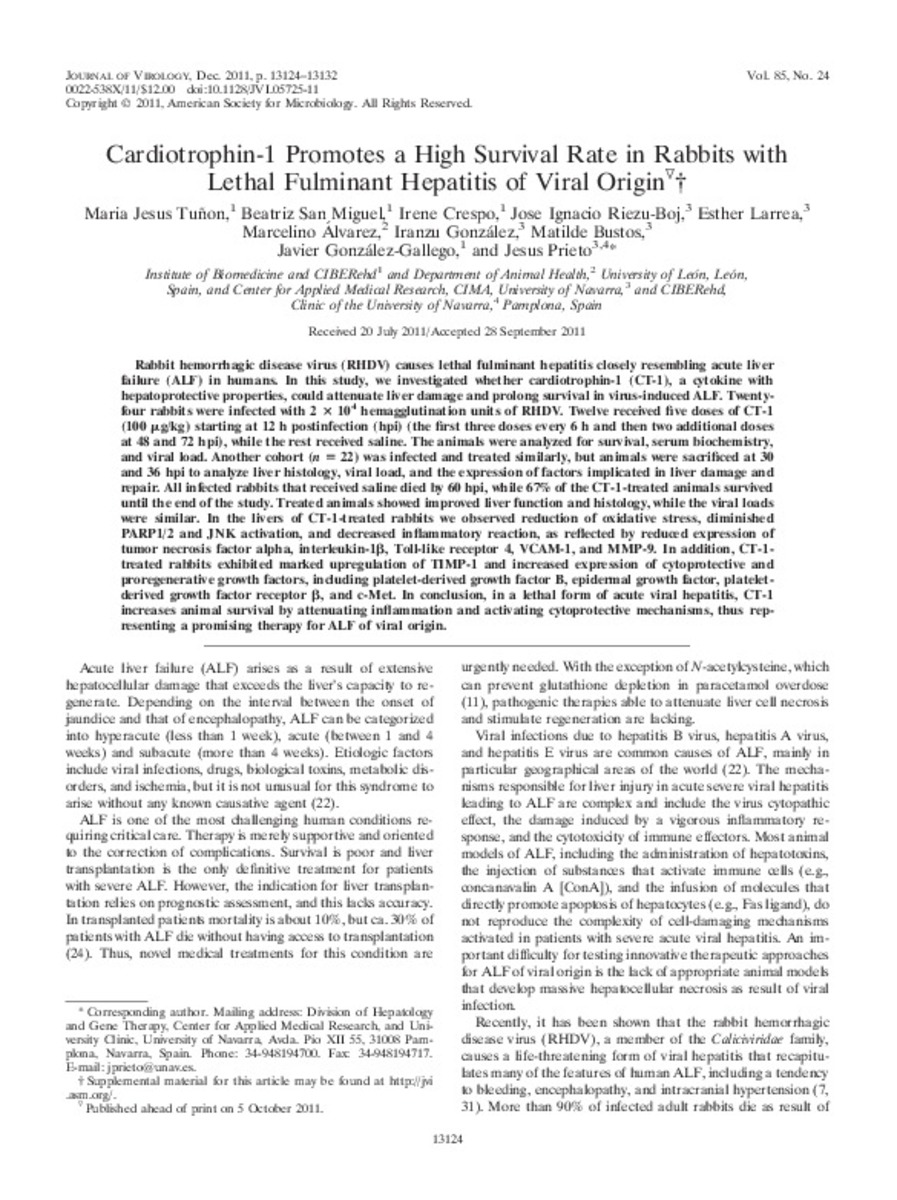Full metadata record
| DC Field | Value | Language |
|---|---|---|
| dc.creator | Tuñon, M.J. (María Jesús) | - |
| dc.creator | San-Miguel, B. (Beatriz) | - |
| dc.creator | Crespo, I. (Irene) | - |
| dc.creator | Riezu-Boj, J.I. (José Ignacio) | - |
| dc.creator | Larrea, E. (Esther) | - |
| dc.creator | Alvarez, M. (Marcelino) | - |
| dc.creator | Gonzalez, I. (Iranzu) | - |
| dc.creator | Bustos, M. (Matilde) | - |
| dc.creator | Gonzalez-Gallego, J. (Javier) | - |
| dc.creator | Prieto, J. (Jesús) | - |
| dc.date.accessioned | 2012-08-10T11:49:17Z | - |
| dc.date.available | 2012-08-10T11:49:17Z | - |
| dc.date.issued | 2011 | - |
| dc.identifier.citation | Tunon MJ, San Miguel B, Crespo I, Riezu-Boj JI, Larrea E, Alvarez M, et al. Cardiotrophin-1 promotes a high survival rate in rabbits with lethal fulminant hepatitis of viral origin. J Virol 2011 Dec;85(24):13124-13132. | es_ES |
| dc.identifier.issn | 1098-5514 | - |
| dc.identifier.uri | https://hdl.handle.net/10171/23051 | - |
| dc.description.abstract | Rabbit hemorrhagic disease virus (RHDV) causes lethal fulminant hepatitis closely resembling acute liver failure (ALF) in humans. In this study, we investigated whether cardiotrophin-1 (CT-1), a cytokine with hepatoprotective properties, could attenuate liver damage and prolong survival in virus-induced ALF. Twenty-four rabbits were infected with 2 × 10(4) hemagglutination units of RHDV. Twelve received five doses of CT-1 (100 μg/kg) starting at 12 h postinfection (hpi) (the first three doses every 6 h and then two additional doses at 48 and 72 hpi), while the rest received saline. The animals were analyzed for survival, serum biochemistry, and viral load. Another cohort (n = 22) was infected and treated similarly, but animals were sacrificed at 30 and 36 hpi to analyze liver histology, viral load, and the expression of factors implicated in liver damage and repair. All infected rabbits that received saline died by 60 hpi, while 67% of the CT-1-treated animals survived until the end of the study. Treated animals showed improved liver function and histology, while the viral loads were similar. In the livers of CT-1-treated rabbits we observed reduction of oxidative stress, diminished PARP1/2 and JNK activation, and decreased inflammatory reaction, as reflected by reduced expression of tumor necrosis factor alpha, interleukin-1β, Toll-like receptor 4, VCAM-1, and MMP-9. In addition, CT-1-treated rabbits exhibited marked upregulation of TIMP-1 and increased expression of cytoprotective and proregenerative growth factors, including platelet-derived growth factor B, epidermal growth factor, platelet-derived growth factor receptor β, and c-Met. In conclusion, in a lethal form of acute viral hepatitis, CT-1 increases animal survival by attenuating inflammation and activating cytoprotective mechanisms, thus representing a promising therapy for ALF of viral origin. | es_ES |
| dc.language.iso | eng | es_ES |
| dc.publisher | American Society for Microbiology | es_ES |
| dc.rights | info:eu-repo/semantics/openAccess | es_ES |
| dc.subject | Caliciviridae infections/veterinary | es_ES |
| dc.subject | Cytokines/administration and dosage | es_ES |
| dc.subject | Hemorrhagic disease virus, rabbit/pathogenicity | es_ES |
| dc.subject | Hepatitis, viral, animal/drug therapy | es_ES |
| dc.subject | Hepatitis, viral, animal/mortality | es_ES |
| dc.subject | Immunologic factors/administration and dosage | es_ES |
| dc.title | Cardiotrophin-1 promotes a high survival rate in rabbits with lethal fulminant hepatitis of viral origin | es_ES |
| dc.type | info:eu-repo/semantics/article | es_ES |
| dc.relation.publisherversion | http://jvi.asm.org/content/85/24/13124 | es_ES |
| dc.type.driver | info:eu-repo/semantics/article | es_ES |
Files in This Item:
Statistics and impact
Items in Dadun are protected by copyright, with all rights reserved, unless otherwise indicated.






